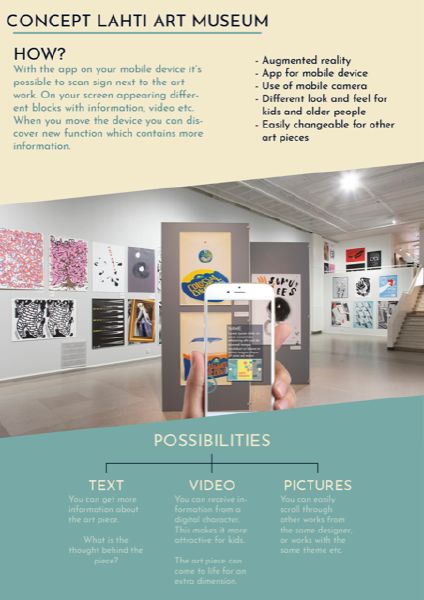With the aim of revitalising the cultural landscape and attractiveness of Lahti, in southern Finland, the Tajumo project developed a modern and ambitious concept for the new Lahti Art & Design Centre, and created a plan to implement it. Due to open in autumn 2021, the new centre focuses on digital technology. It will house museum spaces, an art and design shop, a restaurant and a micro-brewery, while also serving as a meeting space and workplace for professionals working in creative fields.
An experience centre for art and design in Lahti, Finland
- 05 August 2020
The project delivered an in-depth picture of a successful experience centre and a roadmap for how to achieve it. A network of local, national and international operators was established, and the necessary operating model put in place, including the vital co-operation model between Lahti Museums and the Institute of Design.
Led by the Institute of Design at the Lahti University of Applied Sciences, the project brought together a broad range of stakeholders, including Lahti museums and the Lahti City association, which represents private entrepreneurs running their businesses in the city centre. Through a combination of workshops, interviews, research and benchmarking visits in Finland and abroad, the project developed a business and collaboration model, and produced and piloted various service concepts. The project created two new jobs and, once the centre opens, 10-20 jobs are expected to be created.
Assessing needs and involving stakeholders
Once a respected centre of design expertise, Lahti was hit hard by the recession of the early 1990s, when production in its manufacturing industries — including furniture, textiles and clothing — decreased considerably. In recent years, unemployment remained high, and the city has struggled to attract new inhabitants, visitors and businesses. Furthermore, the 70-year lease on the Lahti Art Museum was due to expire at the end of 2018.
It was time for a new strategy, not only to boost the area’s economy, but also to safeguard the city’s cultural heritage and help re-establish Lahti as a centre of design expertise.
Together with the Lahti Museums and other parties, the Tajumo project organised workshops to outline the business model for a new art and design centre at the Malski centre, on the site for the former Mallasjuoma brewery. From the outset, the project fostered an inclusive approach, and every workshop, seminar or event arranged was open to the public.
Over the course of the project, 40 in-depth interviews and tens of discussions and meetings with the stakeholders were conducted to understand the needs and opinions of the many parties involved, including artists, designers, gallerists and other museum actors, creative companies, regional universities, catering businesses and event production services. The project carried out benchmarking studies of digital concepts in over 20 museums, in Finland and abroad.
Defining a roadmap for success
Based on the outcomes of the workshops, studies, research, interviews and other discussions, the project presented alternative options for the interior design and furniture plans of the centre. It developed, tested and piloted several digital solutions including: two events using augmented reality; a virtual furniture exhibition; and 10 digital concepts for exhibitions, museum shop and visitor services.
With detailed descriptions for the implementation of various services in the centre, the project created a plan for establishing a modern, dynamic and financially viable art and design centre that will meet the needs of the city and community of Lahti.
Total investment and EU funding
Total investment for the project “Tajumo” is EUR 598 438, with the EU’s European Regional Development Fund contributing EUR 418 910 through the “Sustainable growth and jobs 2014-2020 - Structural Funds Programme of Finland” Operational Programme for the 2014-2020 programming period. The investment falls under the priority “Research and innovation”.

